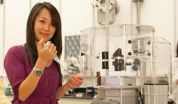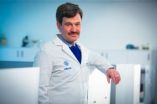(Press-News.org) SALT LAKE CITY, May 16, 2014 – University of Utah researchers devised a way to watch newly forming AIDS virus particles emerging or "budding" from infected human cells without interfering with the process. The method shows a protein named ALIX gets involved during the final stages of virus replication, not earlier, as was believed previously.
"We watch one cell at a time" and use a digital camera and special microscope to make movies and photos of the budding process, says virologist Saveez Saffarian, an assistant professor of physics and astronomy and senior author of a new study of HIV budding published online today in the Public Library of Science journal PLOS ONE.
"We saw ALIX recruited into HIV budding for the first time," he says. "Everybody knew ALIX is involved in HIV budding, but nobody could visualize the recruitment of ALIX into the process."
The finding is "fundamental basic science" and has no immediate clinical significance for AIDS patients because ALIX is involved in too many critical functions like cell division to be a likely target for new medications, Saffarian says.
"We know a lot about the proteins that help HIV get out of the cell, but we do not know how they come together to help the virus get out, and it will be in the next 10 to 20 years that we will know a lot more of about this mechanism," he adds. "Would this be a drug target? Would this be a part of biochemistry used in a therapeutic or biotech industry later on? I can't tell you now. But if it was not because of our curiosity as a species, we would not have the technology we have today."
The new study "is nice work," says HIV budding expert Wes Sundquist, who advised Saffarian and is professor and co-chair of biochemistry at the University of Utah School of Medicine. "It's of genuine interest for those of us who study the mechanism of HIV assembly."
The study was funded by the National Science Foundation. Saffarian conducted the study with first author, Pei-I Ku, a University of Utah doctoral student in physics; Mourad Bendjennat, a postdoctoral fellow in physics and astronomy; technician Jeff Ballew; and Michael Landesman, another postdoctoral fellow in physics and astronomy who previously worked in Sundquist's biochemistry lab.
Watch, Don't Touch, as HIV Buds
Biochemical methods used for years involve collecting millions of viruses in lab glassware and doing different analyses to reveal the proteins that make up the virus – for example, by using antibodies that bind to certain proteins and using other proteins that make the first proteins fluoresce so they can be seen.
"You're not doing it one virus at a time," Saffarian says. "The problem with that is you don't see the differences among similar viruses. And you do not see the timing of how various proteins come and go to help the virus get out of the cell."
Other methods freeze or otherwise fix cells as new HIV particles emerge from them, and use an electron microscope to photograph those freeze-frame views of viral replication. Saffarian also uses technology known as "total internal reflection fluorescence microscopy," which has been used to look at dynamic processes in cells.
The method was used before to make images of the budding of HIV and a similar horse virus, EIAV. But Saffarian says that study didn't show ALIX getting involved in HIV budding, and had flaws that wrongly indicated the ALIX protein got involved quite early in the EIAV budding process, suggesting it did the same in HIV budding.
Ku, Saffarian and colleagues combined that microscopy method with an improved way of genetically linking a green fluorescent "label" to ALIX proteins in cloned cells so they can see the proteins without harming their normal function. The researchers tried numerous so-called "linkers" and found the one that let them see the ALIX proteins as they got involved in HIV budding but without disturbing the process.
Neither the microscope technology nor labeling proteins with green fluorescence are new, but "what we did that is new is we linked these fluorescence proteins to ALIX using many different kinds of linkers" to find one that let the ALIX protein function properly, he adds.
The problem with earlier research – which indicated ALIX was involved early in the budding process – was that only one linker was used, and it impaired ALIX' normal function, Saffarian says.
Looking at Proteins Forming HIV
When HIV replicates inside a human cell, a protein named Gag makes up most of the new particles – there are 4,000 copies of the Gag protein in one HIV particle – although a bunch of other proteins get involved in the process, including ALIX, which stands for "alg-2 interacting protein x." Experiments like those by Saffarian's team use "virus-like particles," which are HIV particles stripped of their genetic blueprint or genome so they don't pose an infection risk in the lab.
"Virus-like particles maintain the same geometry and same budding process as infectious HIV," Saffarian says.
During budding, Gag proteins assemble on the inside of a cell membrane – along with ALIX in the late stages – and form a new HIV particle that pushes its way out of the cell – the process by which AIDS in an infected person spreads from cell to cell.
To look at the budding process, Ku, Saffarian and colleagues place human HELA cells containing the particles in a small amount of liquid growth medium in a petri dish and put it under the microscope, which is in a glass chamber kept at body temperature so the cells can remain alive for more than 48 hours. A solid-state blue laser is aimed at the sample to make the green-labeled ALIX and red-labeled Gag proteins glow or fluoresce so they can be seen as they assemble into a virus particle.
With red-labeled Gag proteins and green-labeled ALIX proteins, "we could see ALIX come at the end of the assembly of the virus particle," with some 100 ALIX proteins converging with the roughly 4,000 Gag molecules and assembling into a new HIV particle. ALIX then brings in two other proteins, which cut the budding virus particle off from the cell when it emerges. ALIX' position during the pinching off of new particles hadn't been recognized before, Saffarian says
The researchers watched the virus particles bud from one cell at a time: usually about 100 of them emerged during a two-hour period. Saffarian says most of the ALIX proteins left when HIV assembly was complete and returned to the liquid inside a cell.
He says the discovery that ALIX doesn't get involved until the late stages of HIV budding suggests the existence of a previously unrecognized mechanism in the virus that regulates the timing of ALIX and other proteins in assembling new HIV particles.
"We discovered that the cellular components that help with the release of the virus actually arrive in a much more complex timing scheme than predicted based on the biochemical data," Saffarian says. "The outcome of this study is promising because it uncovers a new regulatory mechanism for recruitment of cellular components to the HIV budding sites and opens the door to exciting future studies on the mechanism of HIV budding."
Physicists in Virology
Why are physicists studying viruses? First, biophysicists study physical mechanisms in biology, such as motors in cells. Saffarian earned a doctorate in biophysics, developing methods that used fluorescent light to look at cellular processes.
"I got very jealous because I felt every time I contributed to a project, the actual science was somebody else's pursuit," he says. "I was helping them with tools, but not asking fundamental questions myself."
So Saffarian did a postdoctoral fellowship in cell biology at Harvard Medical School, then "decided I wanted to study viruses, how they get out of cells and replicate." In addition to his position in physics, he is an adjunct assistant professor of biology.
INFORMATION:
Video, caption and credit
A 10-second video showing HIV budding with ALIX is at: http://youtu.be/wFSs1eumnXA
Final stages of HIV assembly: This 10-second movie shows the role of a protein named ALIX (labeled green with a fluorescent protein) as it is gets involved in the formation or "budding" of two new human immunodeficiency virus (HIV) particles out of a human cell. The new HIV particles are made mostly of a protein named Gag. The movie shows two places (red) where Gag is assembling to form HIV particles. It shows that green-labeled ALIX proteins get involved late in the process when they bind in a blaze of green color to newly forming virus particles (expanding red spots). That is the key finding of a new University of Utah study led by virologist Saveez Saffarian and physics doctoral student Pei-I Ku. Credit: Pei-I Ku, University of Utah.
University of Utah Communications
75 Fort Douglas Boulevard, Salt Lake City, UT 84113
801-581-6773 fax: 801-585-3350
http://www.unews.utah.edu
Watching HIV bud from cells
University of Utah study shows last-minute role of protein named ALIX
2014-05-17
ELSE PRESS RELEASES FROM THIS DATE:
MicroRNA that could be used to suppress prostate cancer progression found
2014-05-17
CINCINNATI—About one in seven men will develop prostate cancer over the course of a lifetime, and about one in 36 men will die from it.
This is why findings by Cincinnati Cancer Center researchers, showing that a tumor suppressive microRNA, when activated by an anti-estrogen drug, could contribute to development of future targeted therapies, are important.
These findings are published in the May 16, 2014 edition of the journal PLOS ONE.
"MicroRNAs, or miRNAs, are short RNA molecules that play a prominent role in regulating gene expression. One miRNA can target multiple ...
Breakthrough in HIV/AIDS research gives hope for improved drug therapy
2014-05-17
PITTSBURGH, May 16, 2014 – The first direct proof of a long-suspected cause of multiple HIV-related health complications was recently obtained by a team led by the University of Pittsburgh Center for Vaccine Research (CVR). The finding supports complementary therapies to antiretroviral drugs to significantly slow HIV progression.
The study, which will be published in the June issue of the Journal of Clinical Investigation and is available online, found that a drug commonly given to patients receiving kidney dialysis significantly diminishes the levels of bacteria that ...
Transgenic mice produce both omega-3 and omega-6 fatty acids on carbohydrate diet
2014-05-17
Massachusetts General Hospital (MGH) investigators have developed a transgenic mouse that synthesizes both the omega-3 and omega-6 essential fatty acids within its tissues on a diet of carbohydrates or saturated fats. Called "essential" because they are necessary to maintain important bodily functions, omega fatty acids cannot naturally be synthesized by mammals and therefore must be acquired by diet. Significant evidence suggest that the ratio of dietary omega-6 to omega-3 has important implications for human health, further increasing interest in the development of ...
Gender differences stand out in measuring impact of Viagra as therapy for heart failure
2014-05-17
New animal studies by Johns Hopkins cardiovascular researchers strongly suggest that sildenafil, the erectile dysfunction drug sold as Viagra and now under consideration as a treatment for heart failure, affects males and females very differently.
The results of their investigations in varied male and female mouse models of heart failure are so clear-cut, says lead scientist Eiki Takimoto, M.D., Ph.D., that physicians may need to take gender into consideration when prescribing certain medications and that drug developers would be wise to take them into careful account ...
The early earthworm catches on to full data release
2014-05-17
To quote the American cartoonist Gary Larson: all things play a role in nature, even the lowly worm—but perhaps never in such a visually stunning way as that presented in two papers published today in the open access journals GigaScience and PLOS ONE. The work and data presented here provide the first-ever comparative study of earthworm morphology and anatomy using a 3D non-invasive imaging technique called micro-computed tomography (or microCT), which digitizes worm structures. This opens the possibility of scanning millions of specimens from museum collections, including ...
JCI online ahead of print table of contents for May 16, 2014
2014-05-16
Targeting microbial translocation attenuates SIV-mediated inflammation
Patients with HIV often present with signs of immune activation and systemic inflammation, both of which are hypothesized to directly contribute to the development of AIDs in infected individuals. HIV and the related simian immunodeficiency virus (SIV) damage the gut mucosa, leading to translocation of microbes from the intestinal lumen to the general circulation, but it is not clear if microbial translocation is directly responsible for chronic HIV-associated inflammation. In this issue of the Journal ...
Methadone programs can be key in educating, treating HCV patients
2014-05-16
BUFFALO, N.Y. – People who inject drugs and are enrolled in a drug treatment program are receptive to education about, and treatment for, hepatitis C virus, according to a study by researchers at several institutions, including the University at Buffalo.
That finding, published online this week in the Journal of Addiction Medicine will be welcome news to health care providers. The paper notes that injection drug use is a primary mode of infection, making for an HCV infection prevalence as high as 80 percent among people who inject drugs.
"One of the most important findings ...
Non-invasive lithotripsy leads to more treatment for kidney stones
2014-05-16
DURHAM, N.C. – When it comes to treating kidney stones, less invasive may not always be better, according to new research from Duke Medicine.
In a direct comparison of shock wave lithotripsy vs. ureteroscopy – the two predominant methods of removing kidney stones – researchers found that ureteroscopy resulted in fewer repeat treatments.
The findings were published May 16, 2014, in the journal JAMA Surgery, coinciding with presentation at the annual meeting of the American Urological Association.
"Nearly one out of 11 people in the United States has kidney stones, ...
Cognitive behavioral or relaxation training helps women reduce distress during breast cancer treatment
2014-05-16
Coral Gables, Fla. (May 16, 2014) – Can psychological intervention help women adapt to the stresses of breast cancer? It appears that a brief, five-week psychological intervention can have beneficial effects for women who are dealing with the stresses of breast cancer diagnosis and surgery. Intervening during this early period after surgery may reduce women's distress and providing cognitive or relaxation skills for stress management to help them adapt to treatment.
Researchers at the University of Miami recruited 183 breast cancer patients from surgical oncology clinics ...
Spiders spin possible solution to 'sticky' problems
2014-05-16
Researchers at The University of Akron are again spinning inspiration from spider silk—this time to create more efficient and stronger commercial and biomedical adhesives that could, for example, potentially attach tendons to bones or bind fractures.
The Akron scientists created synthetic duplicates of the super-sticky, silk "attachment discs" that spiders use to attach their webs to surfaces. These discs are created when spiders pin down an underlying thread of silk with additional threads, like stiches or staples, explains Ali Dhinojwala, UA's H. A. Morton professor ...
LAST 30 PRESS RELEASES:
URI researchers uncover molecular mechanisms behind speciation in corals
Chitin based carbon aerogel offers a cleaner way to store thermal energy
Tracing hidden sources of nitrate pollution in rapidly changing rural urban landscapes
Viruses on plastic pollution may quietly accelerate the spread of antibiotic resistance
Three UH Rainbow Babies & Children’s faculty elected to prestigious American Pediatric Society
Tunnel resilience models unveiled to aid post-earthquake recovery
Satellite communication systems: the future of 5G/6G connectivity
Space computing power networks: a new frontier for satellite technologies
Experiments advance potential of protein that makes hydrogen sulfide as a therapeutic target for Alzheimer’s disease
Examining private equity’s role in fertility care
Current Molecular Pharmacology achieves a landmark: real-time CiteScore advances to 7.2
Skeletal muscle epigenetic clocks developed using postmortem tissue from an Asian population
Estimating unemployment rates with social media data
Climate policies can backfire by eroding “green” values, study finds
Too much screen time too soon? A*STAR study links infant screen exposure to brain changes and teen anxiety
Global psychiatry mourns Professor Dan Stein, visionary who transformed mental health science across Africa and beyond
KIST develops eco-friendly palladium recovery technology to safeguard resource security
Statins significantly reduce mortality risk for adults with diabetes, regardless of cardiovascular risk
Brain immune cells may drive more damage in females than males with Alzheimer’s
Evidence-based recommendations empower clinicians to manage epilepsy in pregnancy
Fungus turns bark beetles’ defenses against them
There are new antivirals being tested for herpesviruses. Scientists now know how they work
CDI scientist, colleagues author review of global burden of fungus Candida auris
How does stroke influence speech comprehension?
B cells transiently unlock their plasticity, risking lymphoma development
Advanced AI dodel predicts spoken language outcomes in deaf children after cochlear implants
Multimodal imaging-based cerebral blood flow prediction model development in simulated microgravity
Accelerated streaming subgraph matching framework is faster, more robust, and scalable
Gestational diabetes rose every year in the US since 2016
OHSU researchers find breast cancer drug boosts leukemia treatment
[Press-News.org] Watching HIV bud from cellsUniversity of Utah study shows last-minute role of protein named ALIX





